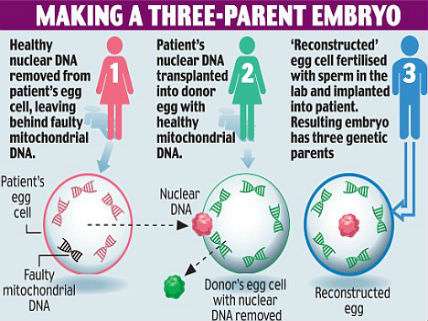Three Parent Babies Approved By British Parliament. Hooray!
Naturally the usual bioluddites are eager to stop progress.

Some women suffer from infertility because the mitochondria in their eggs are defective. In addition, one in 2,500 children are born with diseases associated with broken mitochondria. Mitochondria are the tiny power plants that fuel the activity of all the body's cells and are inherited directly from a baby's mother. Mitochondria have their own small genomes outside of the cellular nuclei where most genes reside. Researchers in the United Kingdom have sought permission to treat infertility and prevent by replacing defective mitochondria using those from donated eggs.
To cure infertility and to prevent children from being born with mitochondrial diseases, fertility specialists are proposing to implement two procedures: (1) maternal spindle transfer and (2) pro-nuclear transfer. In maternal spindle transfer genes are taken from nucleus the egg of the prospective mother whose mitochondria are defective and installed into a donor egg with healthy mitochondria from which nuclear genes have been removed. The reconstituted egg is then fertilized. In pro-nuclear transfer involves taking nuclear material from a fertilized egg before the nuclei of the sperm and egg have fused and installing it into a donated enucleated egg.
Basically, something like 0.1 percent of the DNA in a child born via this technique will have come from the donor and such kids will not pass along the genetic defect to their own progeny.
Mitochondria replacement was actually first pioneered in 2001 in the United States by fertility specialist Jacques Cohen at St. Barnabas Hospital in New Jersey. Some 20 children were born using this technique before the FDA banned it. One of the 20 children was later diagnosed with severe autism, but it is unknown what role, if any, the technique may have played in that outcome.
Naturally the usual bioluddites are eager to stop progress. The Center for Genetics and Society located in Berkeley, California sent around a press release decrying the parliamentary action:
The UK House of Commons voted today to clear the way for fertility clinics to use controversial germline engineering techniques to create embryos with DNA from three people. If also approved by the House of Lords, the bill would enact an exception to the UK's law against inheritable genetic modification, which is also prohibited by more than 40 other countries and several international human rights treaties. Many questions have been raised about the health risks of the techniques, and about the policy implications of crossing the long-held bright line against human germline modification.
"We believe the House of Commons has made a serious mistake, which we hope does not have dire consequences," said CGS Executive Director Marcy Darnovsky, PhD.
Fortunately there are more sensible bioethicists who argue that the technique is ethical and should go forward. New York University bioethicist Arthur Caplan analogizes mitochondria to batteries and writes in Wired …
…some say mitochondrial transplants cross a bright ethical line. Changing genes in the lungs of people with immune disease or in the eyes of people with macular degeneration may fix the broken body part but, critics point out, the change is not passed on to future generations. When you change the mitochondria in an egg with a transplant, you make a change that is inherited by every single offspring of any child created from that egg. That is called germline engineering. Germline engineering of mitochondria moves beyond using genetic engineering to fix our body parts into directly engineering the traits of our children. It is a road that could lead, the critics warn, to eugenics.
Well, that's where they are wrong. Transplanting mitochondria is not going to be the method used to create enhanced babies. Traits like height, intelligence, strength, balance, and vision don't reside in the battery part of our cells.
We may well want to draw the line at genetic engineering aimed at making superbabies but all that is involved with mitochondria transplants is trying to prevent dead or very disabled ones. The latter goal is noble, laudable and ought to be praised not condemned.
I certainly don't want to draw the line at safe genetic engineering used to enhance human capacities, but we will leave that topic for another time. Here's hoping that the House of Lords will vote yea.


Show Comments (18)